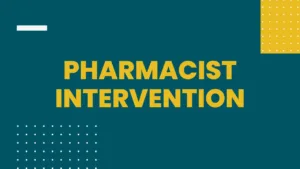Pharmacist intervention

Objective
After completion of this lecture, student will be able to:
• Describe the importance of pharmacist interventions
• Explain different pharmacist interventions
Pharmacist intervention
Definition
Pharmacist intervention is defined as any contact made by pharmacist during the dispensing process with a prescriber or a patient and that was aimed at rationalizing drug prescribing or use
Pharmacist Interventions
Pharmacist intervention aimed at:
• Appropriate pharmacotherapy
• Appropriate indication
• Appropriate medication
• Right dose according to the patient’s clinical condition
• Appropriate administration and duration of treatment
• Appropriate patient
• Patient’s adherence to treatment
• Monitoring of the outcome of pharmacotherapy
• Monitoring and evaluation of possible adverse drug-to-drug reactions related to the treatment
Pharmacist intervention is required in medication related problems such as
• Untreated indications
• Sub-therapeutic dosage
• Medication overdose
• Adverse drug reactions
• Drug interactions
• Drug use without indication
• Improper drug selection
• Failure to receive medications
Untreated indications
• When reviewing the indication for drug therapy it is important to consider whether the indication may be an unrecognized adverse drug reaction
• Example: A patient who is having complaints of nausea may be taking an antibiotic or some other drug may contribute to the problem
Improper drug selection
• It is the pharmacist’s duty to ensure that the most appropriate drug has been chosen to treat the patient’s medical condition
• Example: Short course of NSAID is the usual first line treatment for acute gout. However if the patient has renal impairment a short course of Prednisolone may be most appropriate choice
Sub-therapeutic dose
• The dose below the therapeutic range that does not provide the required pharmacological action
• The therapeutic dose varies from patient to patient
• The dose and the dosing regimen should be individualized based in the patient’s medical condition
TDM can be a useful aid
• Drugs with narrow therapeutic index
• Where there is an established relationship between serum concentration and therapeutic effect
Over-dosage
• Over-dosage occurs when a patient takes a drug takes a drug for a longer period than necessary
• It can also occur if the same generic drug has been prescribed twice under different brand names
Example: Antibiotic treatment may be continued after an infection has resolved
• Thereby exposing the patient to unnecessary risk of ADR
• Additional expense
Failure to receive medications
It can occur due to many factors including
• Non adherence
• Poor administration techniques
• Missed doses due to medication errors, substandard drugs
• Patient’s inability to pay for the prescribed drug
Example: A patient with newly diagnosed hypertension who has been
• Prescribed an ACE inhibitor may continue to have high BP
• Patient fails to take the drug because of its high cost
Adverse drug reactions
• Pharmacist should check that the patient is not allergic to the prescribed drug or has had an adverse reaction to any drug in the past
• Patient who are most susceptible to develop an ADR should be identified and monitored on a daily basis
• Example: Meformin-Weight loss
Aspirin, clopidogrel- GI bleeding
Drug -Drug Interactions
Drug interactions vary in their clinical significance
• The pharmacist needs to make a professional judgment
• To change in drug therapy is necessary
Example: A Patient who has been prescribed Ciprofloxacin and iron tablets
• Ciprofloxacin absorption is reduced if these drugs are given together
• The problem can be resolved by spacing the doses of these drugs several hours apart
Drug use without indication
Pharmacist should verify that the patient have a medical condition that is the:
• Result of taking a drug
• For which there is no valid indication
Example: Tricyclic antidepressants are often used for indications such as
• Urinary frequency
• Neuropathic pain
• Pruritus
• A pharmacist who concludes that a prescription for Amitriptylline has no indication because the patient has no depression may be an incorrect conclusion
Summary
• Pharmacist intervention is defined as any contact made by a pharmacist during the dispensing process with a prescriber or a patient and that was aimed at rationalizing drug prescribing or use
• Pharmacist Interventions
• Untreated indications
For Pharmacist intervention PDF Notes Click on Download Button
